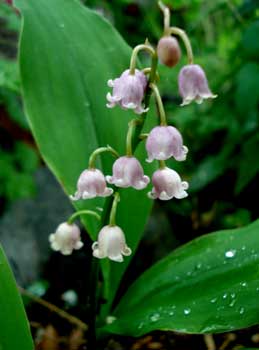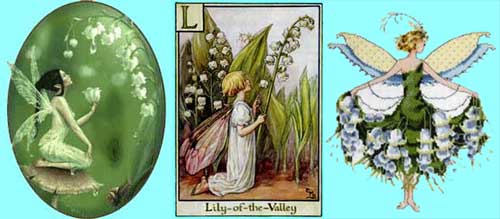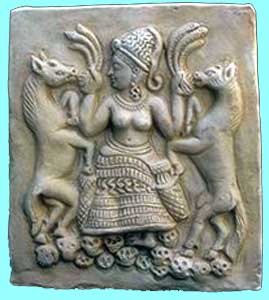
Pink Lily of the Valley
"Sweetest of the flowers a-blooming
In the fragrant vernal days
Is the Lily of the Valley
With its soft, retiring ways."
-Paul Laurence Dunbar
(1872-1906)
Regular white Lily of the Valley is notoriously aggressive; it can displace everything in its path. I remember years ago, the first time I saw the beauteous pink variant (Convallaria majali s var rosea), I asked if it was just as spready as the white. I was told it probably would be, rhizomes being dense enough to use for ground erosion control on hillsides.(1872-1906)
So I planted some of it in a couple harsh areas, where it scrabbled along piteously for two years, until I dug it up & put it in a nice spot with regular watering, where they of course did swell. If (or when) they try to take over nearby space, I'll just dig them out & pot them up to take to the street fair. They can crowd even themselves so densely that bloom falls off, but they just need to be dug up & divided, but they'll go years before that's essential.
The long pointed foliage grows six to ten tall & lasts spring to first frost. Each planting will spread over time, & its usually recommended to place every single plant a foot apart, though I gave them six inches.
They love bright shade or even fairly dark shade, though ours were moved to an afternoon-sunny location & they never suffer just so long as they're well enough watered (in shade they can go all but unwatered). They're for all intent & purposes immortal & will probably never die out of the garden even if you abuse them.
Scented pale pink flowers occur in early & mid spring in zone 7/8, dangling bells on long enough stems to make good choices for bouquets. We haven't gotten the berries so far, but sometimes the flowers are followed by reddish orange berries that last a very long time. These, like the entire plant, are toxic. If you ate enough of it, you'd have a heart attack, rich as it is in "cardiac glycosides."
It's extremely cold hardy & can be grown to Zone 4 without trouble, but in warmer climates, it doesn't usually succeed. The Pacific Northwest is about as hot as they can stand without the foliage getting grubby during summer.
 Lily of the Valley is one of those flowers that attracts folklore, being alleged to belong to the fairies, to be a charm that is proof against witches' spells, or insure successful marriages, even to induce visions of Heaven by its scent.
Lily of the Valley is one of those flowers that attracts folklore, being alleged to belong to the fairies, to be a charm that is proof against witches' spells, or insure successful marriages, even to induce visions of Heaven by its scent.Among its folk-names are Fairy Bells because they ring when the fairies sing; & Fairy Cups becauses the fairies used the miniature thimble-shaped flowers to drink fairy-wine. There are scores of pictorial representations of Lily-of-the-Valley fairies, three shown here: first by Rachel Anderson; in the center by Cicely Mary Barker; & third a cross-stitch lily-of-the-valley fairy.
Many of its names have religious significance, including Ladder to Heaven, May Lily, & even its most common name Lily of the Valley. The name Our Lady's Tears was coopted to Mary-worship, though formerly the flower was sacred to the Goddess Maia, as it was believed to be the first flower to bloom in May, the month of Maia, though Mary inherited Maia's title Queen of May.
In many so-called "Astarte plaques" from the Mid & Near East, one sees the Divine Mother in maidenly aspect holding lilies or lotuses. We are told "Wisdom puts forth Her flowers" [Sirach 39:14] for the Mother -- who is the Divine Shekhinah -- is "the one lily" & greatest of all flowers of the world [2 Esdra 5:24].
Often scripture's lily references are to the Egyptian lotus or to large oriental lilies. But the Great Mother is also specifically the Lily of the Valley because she is the Lower Shekhinah, that divine emanation of God closest to the Earth, at the bottom of the sephiroth tree [Zohar III:107a]. As Queen of the Dead as well as the Living, she said, "My dead bodies shall rise. Awake & sing ye that dwell in the dust" [Isaiah 26:19; Midrash Tehillim 1:20].
The Hebrew word for Lily os Shushan, & "Shushan of the Valley" was one of the epithets for the Bride of Solomon [Song of Songs 2:1], & by no means coincidentally the name of the Great Mother of the Elamites or ancient Persians, called variously Shoshan, Susiana, or En-susinak, pretty much the same as the Akkadian Goddess Mami Nintu, but in youthfully nubile form resembling Roman Flora or Greek Maia.
The Jewish heroine Susanna was named for Shoshan the Great Mother, & Esther lived in the city of Susa named for this very Persian Goddess. The reason she's alluded to in the Song of Songs is because that great & sacred poem borrows from so much older divine poetry of the heiros gamos of God & His Bride.
When Solomon sings, "My darling you are like My Mare" [Song 1:9], the word for mare, susah, puns with shushan, & indeed the Elamite goddess En-Susinak & her consort El-Susinak sometimes had the form of a Mare & a Stallion. This is why Jeremiah, born in a city named for Anath, lampooned the Lusty Stallion & his Wife [Jr. 5:8], a typical Yahwist put-down of a rival cult.
 The "Astarte" plaque shown here depicts the West Semitic Goddess Anath whom Jeremiah noted was worshipped by his fellow Jews & especially by women as the Queen of Heaven [Jr 7:18; 44:15-24; 48:13]. At Bethel, in days of the judaism of Jacob, Yahweh was worshipped with his brides, one of whom was Anath. In this plaque She is holding henna because she used henna to dye her hands -- or her hands were red with the blood of her enemies, looking like henna. She is flanked by the divine horses (Anath having given birth to all plants & all animals after laying with her resurrected Brother Baal).
The "Astarte" plaque shown here depicts the West Semitic Goddess Anath whom Jeremiah noted was worshipped by his fellow Jews & especially by women as the Queen of Heaven [Jr 7:18; 44:15-24; 48:13]. At Bethel, in days of the judaism of Jacob, Yahweh was worshipped with his brides, one of whom was Anath. In this plaque She is holding henna because she used henna to dye her hands -- or her hands were red with the blood of her enemies, looking like henna. She is flanked by the divine horses (Anath having given birth to all plants & all animals after laying with her resurrected Brother Baal).Anath was both Goddess of warfare/death & of procreation/life; hence her mastery in this plaque of animals & grains, while treading, Kali-like, upon skulls.
The Jews of Elephantine, Egypt, continued to worship this Goddess as bride of Yahweh even after the fall of the Temple to Rome, essentially adhering to an older form of Judaism that came out of Bethel. When we see these Near Eastern Goddess images, we're glimpsing something of the original Judaism as known even to Abraham & Jacob.
Because Shushan the Lily or Susah the Mare was a non-Hebrew divinity, outside of the Song of Songs she is somewhat deplored, as when the Hebrews are warned not to rely on horses [Hosea 14:3].
According to legend, the Lily of the Valley sprang from the tears of Eve upon the fall from Paradise. They are also known as Jacob's Tears, alluding to scripture's notices of Jacob weeping [Genesis 37:35; Hosea 12:4]. This weeping was in grief for Joseph, & for Rachel. All his other sons & daughters could not console him. The association of the Lily of the Valley with sorrowfulness is very old. Many believed it was bad luck merely to have this flower in one's garden, for it belonged only upon a grave.
It was also said to have sprung from the commingled blood of St. Leonard & a dragon, emulating such myths as hyacinths springing from the blood of Hyachinthus. In 559 C.E., Leonard of Noblac retired from warfare, planning to spend the rest of his life amidst woodland peace & wildflowers in the Vienne Valley in France. But a dragon destroyed his hut & demanded he leave the forest, resulting in the bloody clash of brute force & will.
Lilies of the valley were formerly distilled into a liquor which was believed to cure all manner of illness, though all it did was get the user tipsy so that whatever ailed didn't seem to matter so much.